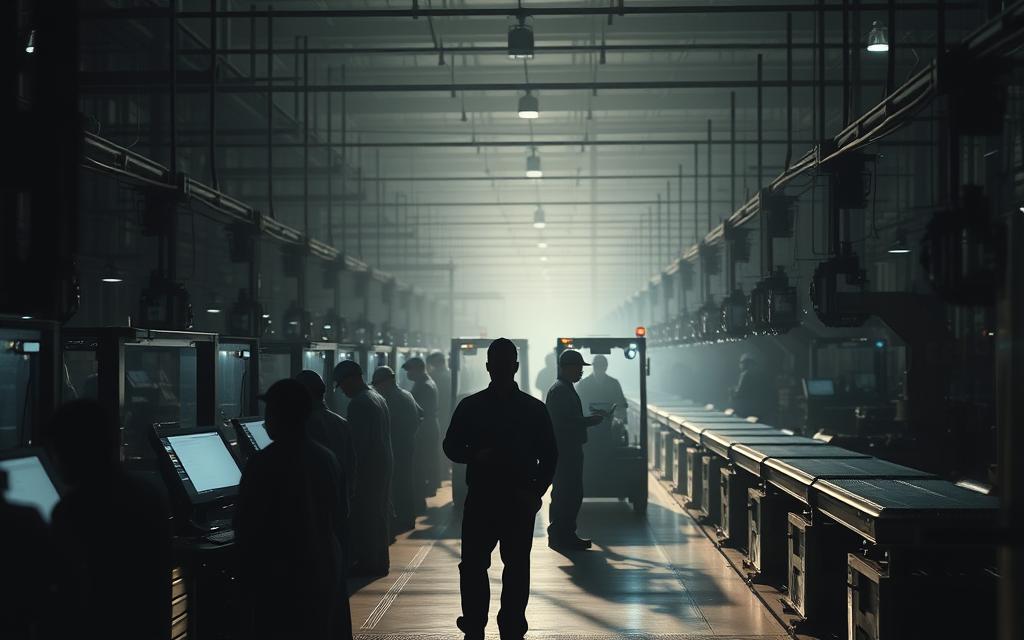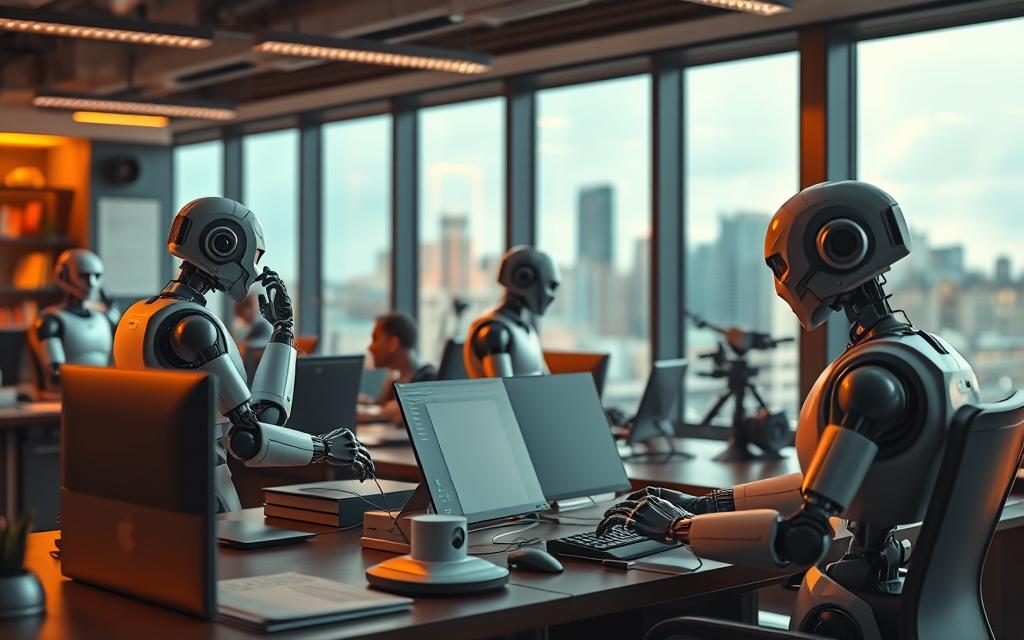The debate over whether robots will take over human jobs has been ongoing for years, blurring the lines between science fiction and reality.
As technology advances at an unprecedented rate, the possibility of automation replacing certain human jobs becomes more plausible. However, this shift also brings about new opportunities and challenges.
The future of work is a topic of much discussion, with many experts weighing in on the potential consequences of increased automation. While some jobs may be lost, others will be created, and many will be transformed.
The Evolution of Automation Anxiety
For centuries, the introduction of new technologies has sparked fears about job security. The anxiety surrounding automation is not a new phenomenon, but rather a recurring theme throughout history.
Historical Fears of Technology Replacing Workers
The Industrial Revolution marked a significant turning point in the history of automation anxiety. As machines began to perform tasks previously done by humans, concerns about job displacement grew. This fear was not unfounded, as many workers saw their roles being replaced by mechanized processes.
From Luddites to Modern Tech Skepticism
The Luddite movement in the early 19th century is a well-known example of resistance against technological change. While the Luddites were primarily concerned with the impact of textile machinery on their livelihoods, modern tech skepticism encompasses a broader range of concerns, including AI and robotics.
Why This Time Might Be Different
The current era of automation is distinct due to the rapid progress in AI and robotics. Unlike previous technological advancements, today’s automation has the potential to affect not just manual labor but also knowledge-based industries. This shift has led to increased concerns about job displacement and the need for workers to adapt to new technologies.
The evolution of automation anxiety reflects changing societal attitudes towards technology and its role in the workforce. As we move forward, understanding this historical context will be crucial in addressing the challenges posed by automation.
Current State of Robotics Technology
The field of robotics is experiencing a paradigm shift, driven by innovations in automation and artificial intelligence. Robotics technology has advanced significantly, enabling robots to perform a wide range of tasks with precision and efficiency.
What Today’s Physical Robots Can and Cannot Do
Today’s physical robots are capable of performing complex operations, from assembly and manufacturing to service and healthcare tasks. However, despite these advancements, there are still limitations to what robots can do, particularly in tasks that require human-like dexterity or complex decision-making.
Capabilities: Robots can efficiently handle repetitive tasks, work in hazardous environments, and perform precision tasks that are challenging for humans.
Limitations: Robots still struggle with tasks that require nuanced human judgment, adaptability in unstructured environments, and complex problem-solving without extensive programming.
Industrial Automation Capabilities
Industrial automation has seen significant advancements, with robots becoming increasingly sophisticated. Machine learning and computer vision have enabled robots to undertake complex operations with precision, improving manufacturing efficiency and reducing costs.
- Enhanced precision and speed in manufacturing processes
- Improved safety through the automation of hazardous tasks
- Increased flexibility with the ability to reprogram robots for different tasks
Service Robot Advancements
Service robots are being designed to interact with humans in various settings, such as homes, hospitals, and public spaces. These robots are equipped with advanced sensors and AI algorithms, enabling them to perform tasks that require human interaction.
Examples include robots used in healthcare for patient care, robots that assist in household chores, and robots that provide customer service.
The AI Revolution Beyond Physical Robots
Beyond the visible robots, a silent AI revolution is underway, reshaping our world. This revolution is not just about machines that can perform physical tasks; it’s about systems that can think, learn, and interact in complex ways.
Machine Learning and Decision-Making Algorithms
At the heart of this revolution are machine learning algorithms that enable computers to analyze vast amounts of data, make predictions, and automate decision-making processes. These algorithms are becoming increasingly sophisticated, allowing businesses to make more informed decisions and improve operational efficiency.
Natural Language Processing and Creative AI
Natural Language Processing (NLP) has enabled computers to understand and generate human-like language, opening up new possibilities for human-computer interaction. Creative AI applications, such as generating art or music, are also pushing the boundaries of what we thought was possible.
The Difference Between Narrow and General AI
It’s crucial to distinguish between narrow or specialized AI and general AI. While narrow AI is designed to perform specific tasks, general AI aims to match human intelligence across a wide range of activities. Currently, most AI applications fall into the narrow category, but research into general AI is ongoing.
The AI revolution is transforming industries and redefining the nature of work. As we move forward, understanding the capabilities and limitations of AI will be key to harnessing its potential.
Industries Already Transformed by Automation
The automation wave has swept across multiple sectors, revolutionizing business operations and unlocking new efficiencies. This transformation has been particularly evident in several key industries that have embraced automation to enhance their operations.
Manufacturing: The First Frontier
Manufacturing was one of the first industries to be heavily automated. Robots have been used for assembly, welding, and inspection, significantly improving production efficiency and reducing costs. Automated manufacturing systems have enabled companies to produce high-quality products at a faster rate and with greater consistency.
Agriculture and Warehouse Operations
Agriculture and warehouse operations have also seen significant automation. The use of drones for crop monitoring and autonomous vehicles for harvesting has increased efficiency in agriculture. In warehouses, robotic picking systems have streamlined the order fulfillment process, reducing labor costs and improving accuracy.
Customer Service and Retail Transformation
The customer service and retail sectors have been transformed by the adoption of chatbots and online platforms. These technologies have enabled businesses to provide 24/7 customer support, improving customer satisfaction and reducing operational costs. Retailers have also leveraged automation to optimize their supply chains and inventory management.
Financial Services and Algorithmic Trading
Financial services have adopted algorithmic trading and automated risk management systems to enhance their operations. Algorithmic trading allows for faster and more accurate trading decisions, while automated risk management systems help mitigate potential losses. These technologies have improved the efficiency and profitability of financial institutions.
In conclusion, automation has already had a profound impact on various industries, including manufacturing, agriculture, customer service, and financial services. As automation continues to evolve, it is likely that even more industries will be transformed, leading to new opportunities for growth and efficiency.
Between Sci-Fi and Reality: Will Robots Replace Human Jobs?
In the ongoing discourse about the future of work, one question stands out: will robots and AI replace human jobs, or will they enhance our capabilities? As we navigate this complex issue, it’s crucial to differentiate between the sensationalism often surrounding automation and the actual technological advancements being made.
Separating Hype from Genuine Technological Trends
The rapid development of robotics and AI has led to both excitement and concern about their potential impact on employment. While some predictions suggest a future where robots perform most tasks, others argue that these technologies will primarily augment human capabilities. To understand the true implications, we must look beyond the hype and examine the current state of these technologies.
Current advancements in robotics have shown significant improvements in areas such as industrial automation and service robotics. However, the extent to which these technologies can replace human judgment, creativity, and complex decision-making is still limited.
Timeline Predictions from Leading Experts
Experts in the field offer varying predictions about when and how robots and AI will significantly impact the workforce. Some forecasts suggest that within the next two decades, a substantial portion of jobs could be automated, while others propose a more gradual transition. Understanding these predictions and their underlying assumptions is key to preparing for the future.
- Short-term: Automation of routine and repetitive tasks
- Medium-term: Augmentation of human capabilities in complex tasks
- Long-term: Potential for significant job displacement in certain sectors
The Augmentation vs. Replacement Debate
The debate over whether robots will replace or augment human workers is multifaceted. Proponents of the augmentation hypothesis argue that while robots and AI will certainly change the nature of work, they will also create new opportunities for human employment and entrepreneurship. On the other hand, those concerned about job displacement emphasize the need for proactive measures to support workers who may lose their jobs due to automation.
Ultimately, the future of work will likely involve a combination of both augmentation and replacement. By understanding the trends and preparing accordingly, we can work towards a future where the benefits of technological advancements are shared by all.
Jobs Most Vulnerable to Automation
With technological advancements happening at a rapid pace, understanding which jobs are most at risk from automation is crucial. As machines and AI become more capable, certain roles are becoming increasingly vulnerable to being replaced.
Routine and Repetitive Task Positions
Jobs that involve routine and repetitive tasks are among the most susceptible to automation. Manufacturing line workers, data entry clerks, and other positions that require performing the same tasks repeatedly are being automated through the use of robotics and machine learning algorithms.
Data Processing and Analysis Roles
The rise of advanced data analytics tools is also impacting jobs that involve data processing and analysis. While human insight is still valuable, many routine data analysis tasks can now be performed by sophisticated software, reducing the need for human intervention in these areas.

Transportation and Logistics
The transportation and logistics sectors are undergoing significant changes due to the development of autonomous vehicles and drones. Self-driving trucks and delivery vans are being tested and implemented, potentially altering the landscape for drivers and related logistics personnel.
Middle-Skill White Collar Work
Middle-skill white collar jobs, including tasks such as bookkeeping, document processing, and certain aspects of financial analysis, are also at risk. Advancements in AI are enabling software to perform tasks that previously required human intelligence, such as understanding documents and making basic financial decisions.
| Job Category | Automation Risk | Key Factors |
|---|---|---|
| Routine and Repetitive Tasks | High | Robotics, Machine Learning |
| Data Processing and Analysis | Medium to High | Advanced Data Analytics |
| Transportation and Logistics | High | Autonomous Vehicles, Drones |
| Middle-Skill White Collar | Medium | AI, Software Automation |
Jobs Likely to Remain Human-Dominated
As automation increases, it’s clear that some jobs will remain firmly in human hands. While technology continues to advance, certain professions require a level of creativity, empathy, and complex decision-making that is difficult to replicate with AI alone.
Creative Professions
Creative and artistic professions are among those least likely to be heavily automated. Jobs in this category include artists, writers, musicians, and designers. The originality and imagination required in these fields make it challenging for AI to fully replace human creativity.
Healthcare and Caregiving
Healthcare and caregiving roles involve complex human interactions and empathy, making them less susceptible to automation. Nurses, doctors, and caregivers provide emotional support and nuanced care that is currently beyond the capabilities of AI and robotics.
Complex Decision-Making and Leadership
Complex decision-making and leadership roles require a level of human judgment and strategic thinking that is hard to automate. Executives, managers, and leaders in various industries must navigate complex situations, make ethical decisions, and inspire their teams—tasks that are difficult to replicate with algorithms alone.
Jobs Requiring Emotional Intelligence
Jobs that require emotional intelligence, such as counselors, social workers, and psychologists, are also likely to remain human-dominated. These professionals provide emotional support, understand subtle human cues, and build trust with their clients—capabilities that are uniquely human.
| Job Category | Reasons for Human Domination | Examples of Jobs |
|---|---|---|
| Creative Professions | Originality and Imagination | Artists, Writers, Designers |
| Healthcare and Caregiving | Complex Human Interactions, Empathy | Nurses, Doctors, Caregivers |
| Complex Decision-Making and Leadership | Human Judgment, Strategic Thinking | Executives, Managers, Leaders |
| Jobs Requiring Emotional Intelligence | Emotional Support, Understanding Human Cues | Counselors, Social Workers, Psychologists |
Understanding which jobs are less likely to be automated can help in focusing education and training efforts on developing skills that complement technological advancements.
Economic Implications of Widespread Automation
As automation becomes increasingly prevalent, its economic implications are becoming a pressing concern for businesses and policymakers alike. The potential effects of automation on the economy are multifaceted, ranging from significant productivity gains to concerns about wealth distribution and inequality.
Productivity and Growth
Automation is expected to drive productivity gains, enabling businesses to produce more with less labor. This increase in efficiency can lead to economic growth, as companies become more competitive in the global market.
Wealth Distribution Concerns
However, there are concerns that the benefits of automation may not be evenly distributed. Those who own the machines may reap most of the benefits, potentially exacerbating wealth inequality. Policymakers will need to consider strategies to mitigate this effect.
New Business Models
Automation is also likely to give rise to new business models and job categories that we cannot yet anticipate. This could lead to the creation of new opportunities for employment and economic growth.
Impact on Economies
The impact of automation on developing economies versus developed economies could vary significantly. Developing economies may face particular challenges in adapting to automation, given their current economic structures.

| Economic Aspect | Potential Impact of Automation | Mitigation Strategies |
|---|---|---|
| Productivity | Significant gains due to increased efficiency | Invest in retraining programs for workers |
| Wealth Distribution | Potential for increased inequality | Implement policies to redistribute wealth, such as progressive taxation |
| New Business Models | Emergence of new industries and job categories | Encourage entrepreneurship and innovation through funding and support |
Preparing for an Automated Future
Preparing for a future where automation plays an even larger role in our economy requires a multifaceted strategy. As automation technologies continue to advance, it’s crucial to develop approaches that support both workers and businesses.
Education and Reskilling Strategies
One of the key elements in preparing for an automated future is education and reskilling. This involves not just training workers in new technologies but also fostering skills that are complementary to automation, such as creativity, critical thinking, and emotional intelligence.
- Emphasizing STEM education
- Providing vocational training in emerging technologies
- Encouraging lifelong learning programs
Policy Responses: From UBI to Job Guarantees
Governments are exploring various policy responses to mitigate the impact of automation on employment. Two prominent ideas are Universal Basic Income (UBI) and job guarantee programs.
| Policy | Description | Potential Benefits |
|---|---|---|
| Universal Basic Income | Providing a regular stipend to all citizens | Financial security, simplicity |
| Job Guarantee | Ensuring employment for all willing workers | Employment stability, social integration |
Human-Machine Collaboration Models
Another approach to preparing for automation is developing human-machine collaboration models. By designing systems where humans and machines work together effectively, we can leverage the strengths of both.
Corporate Responsibility in the Automation Age
Corporations also have a significant role to play in preparing for an automated future. This includes adopting practices that promote a more equitable distribution of the benefits of automation and supporting workers through transition periods.
By focusing on education, policy responses, human-machine collaboration, and corporate responsibility, we can work towards a future where the benefits of automation are realized while minimizing its negative impacts.
Conclusion: Navigating the Future of Work
The future of work is being reshaped by rapid advancements in automation and AI, leading to a significant workforce transformation. As we navigate this change, understanding the current state of robotics and AI is crucial. Industries are being transformed, and jobs are being impacted, with some being more vulnerable to automation than others.
To mitigate the negative effects and maximize the benefits, investing in education and reskilling is essential. Exploring policy responses and promoting human-machine collaboration can also help. The goal is to create a future where technology enhances human capabilities, leading to a more prosperous and equitable society.
Navigating the future of work requires a comprehensive approach, embracing the potential of automation and AI while ensuring that the workforce is prepared for the changes ahead. By doing so, we can unlock new opportunities and create a brighter future for all.




